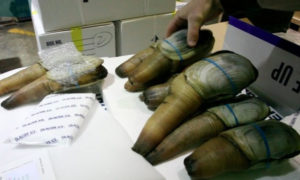The mystery about China’s ban on Northwest shellfish seems on the way to being solved. Original post by Tony Schick of Earthfix is here.
By Tony Schick
Officials in Washington have learned that inorganic arsenic was the toxin detected in a shipment of geoduck from their state to China, not the toxin causing paralytic shellfish poisoning, or PSP, as they previously believed.
That shipment, along with one from Ketchikan, Alaska, led China to ban on all imports of shellfish harvested along the West Coast from Northern California up through Alaska.
The Washington shipment was traced to a tract harvested by the Puyallup Tribe in Redondo, Wash., near Poverty Bay and Dumas Bay.
After learning about the ban but receiving little information from Chinese inspectors about the tests performed, Washington environment and health officials had previously focused their investigation on the toxin that causes paralytic shellfish poisoning, often called the ‘red tide toxin.’ They found no levels of PSP matching the reports out of China.
On Wednesday night, Jerrod Davis of the Washington Department of Health sent an email to alert the commercial shellfish industry. “We received confirmation this morning that the shipment related to our state was an arsenic concern; the shipment related to Alaska was a PSP concern,” Davis wrote.
This news shifts the focus of Washington’s investigation. The state had previously focused its efforts on PSP for a couple of reasons. For one, there are no federal safety standards for arsenic in shellfish. And two, according to the email from Davis, “Previous tests conducted by our agency in the areas where we expected arsenic to be high have shown that even in these areas the shellfish are safe to eat.”
Arsenic has been a concern previously in the Redondo area and for the Puyallup Tribe that harvests its geoduck. In 2007, after the tribe asked the state to consider opening the area for harvest, the state and federal government conducted a study to evaluate whether sewage outfalls in the area had contaminated the geoduck beds. A former smelting site was noted in that study as a potential source of metal contamination.
That study paid close attention to arsenic, which along with cadmium were re-evaluated as “chemicals of concern.” But additional evaluation found levels that posed no apparent threat to human health, according to Dave McBride, a toxicologist with the Washington Department of Health.
“All of our past testing done on geoducks as well as other shellfish in Puget Sound indicates that they are between 10 and 20 times lower in inorganic (arsenic) than what the Chinese standard is,” McBride said.
Those 2007 tests weren’t actually for inorganic arsenic, specifically, McBride said. What the state inspectors did is test for total arsenic, and from there they estimated the level of inorganic arsenic within it based on what they’d seen in other studies.
McBride said the state plans to revisit the area and test specifically for inorganic arsenic.
